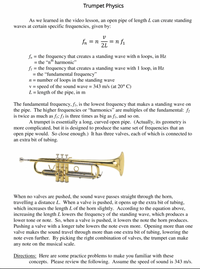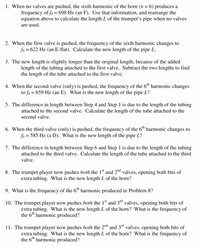
College Physics
11th Edition
ISBN: 9781305952300
Author: Raymond A. Serway, Chris Vuille
Publisher: Cengage Learning
expand_more
expand_more
format_list_bulleted
Concept explainers
Topic Video
Question
#6 in second image

Transcribed Image Text:Trumpet Physics
As we learned in the video lesson, an open pipe of length L can create standing
waves at certain specific frequencies, given by:
fn
= n f1
2L
= n
fn = the frequency that creates a standing wave with n loops, in Hz
= the "nth harmonic"
fi = the frequency that creates a standing wave with 1 loop, in Hz
= the "fundamental frequency"
n = number of loops in the standing wave
v = speed of the sound wave = 343 m/s (at 20° C)
L= length of the pipe, in m
%3D
The fundamental frequency, f1, is the lowest frequency that makes a standing wave on
the pipe. The higher frequencies or “harmonics" are multiples of the fundamental: f2
is twice as much as f1; f3 is three times as big as f1, and so on.
A trumpet is essentially a long, curved open pipe. (Actually, its geometry is
more complicated, but it is designed to produce the same set of frequencies that an
open pipe would. So close enough.) It has three valves, each of which is connected to
an extra bit of tubing.
When no valves are pushed, the sound wave passes straight through the horn,
travelling a distance L. When a valve is pushed, it opens up the extra bit of tubing,
which increases the length L of the horn slightly. According to the equation above,
increasing the length L lowers the frequency of the standing wave, which produces a
lower tone or note. So, when a valve is pushed, it lowers the note the horn produces.
Pushing a valve with a longer tube lowers the note even more. Opening more than one
valve makes the sound travel through more than one extra bit of tubing, lowering the
note even further. By picking the right combination of valves, the trumpet can make
any note on the musical scale.
Directions: Here are some practice problems to make you familiar with these
concepts. Please review the following. Assume the speed of sound is 343 m/s.

Transcribed Image Text:1. When no valves are pushed, the sixth harmonic of the horn (n = 6) produces a
frequency of f6 = 698 Hz (an F). Use that information, and rearrange the
equation above to calculate the length L of the trumpet's pipe when no valves
are used.
2. When the first valve is pushed, the frequency of the sixth harmonic changes to
fo = 622 Hz (an E-flat). Calculate the new length of the pipe L.
3. The new length is slightly longer than the original length, because of the added
length of the tubing attached to the first valve. Subtract the two lengths to find
the length of the tube attached to the first valve.
4. When the second valve (only) is pushed, the frequency of the 6™ harmonic changes
to fo = 659 Hz (an E). What is the new length of the pipe L?
5. The difference in length between Step 4 and Step 1 is due to the length of the tubing
attached to the second valve. Calculate the length of the tube attached to the
second valve.
6. When the third valve (only) is pushed, the frequency of the 6th harmonic changes to
fo = 585 Hz (a D). What is the new length of the pipe L?
7. The difference in length between Step 6 and Step 1 is due to the length of the tubing
attached to the third valve. Calculate the length of the tube attached to the third
valve.
8. The trumpet player now pushes both the 1" and 2nd valves, opening both bits of
extra tubing. What is the new length L of the horn?
9. What is the frequency of the 6th harmonic produced in Problem 8?
10. The trumpet player now pushes both the 1st and 3ª valves, opening both bits of
extra tubing. What is the new length L of the horn? What is the frequency of
the 6th harmonic produced?
11. The trumpet player now pushes both the 2nd and 3d valves, opening both bits of
extra tubing. What is the new length L of the horn? What is the frequency of
the 6th harmonic produced?
Expert Solution
arrow_forward
Step 1

Step by stepSolved in 2 steps with 1 images

Knowledge Booster
Learn more about
Need a deep-dive on the concept behind this application? Look no further. Learn more about this topic, physics and related others by exploring similar questions and additional content below.Similar questions
- Please answer question 8 and fill in the blanks to the second image. Thank youarrow_forwardPlease complete the drawings, if necessary, based on the name/type of diagrams named on top and then determine the focal length for each. This is the complete question.arrow_forwardUsing the numbers 110.1, 121.8, 132.3, 143.0, 153.2 please fill in the table in the image attachedarrow_forward
arrow_back_ios
arrow_forward_ios
Recommended textbooks for you
 College PhysicsPhysicsISBN:9781305952300Author:Raymond A. Serway, Chris VuillePublisher:Cengage Learning
College PhysicsPhysicsISBN:9781305952300Author:Raymond A. Serway, Chris VuillePublisher:Cengage Learning University Physics (14th Edition)PhysicsISBN:9780133969290Author:Hugh D. Young, Roger A. FreedmanPublisher:PEARSON
University Physics (14th Edition)PhysicsISBN:9780133969290Author:Hugh D. Young, Roger A. FreedmanPublisher:PEARSON Introduction To Quantum MechanicsPhysicsISBN:9781107189638Author:Griffiths, David J., Schroeter, Darrell F.Publisher:Cambridge University Press
Introduction To Quantum MechanicsPhysicsISBN:9781107189638Author:Griffiths, David J., Schroeter, Darrell F.Publisher:Cambridge University Press Physics for Scientists and EngineersPhysicsISBN:9781337553278Author:Raymond A. Serway, John W. JewettPublisher:Cengage Learning
Physics for Scientists and EngineersPhysicsISBN:9781337553278Author:Raymond A. Serway, John W. JewettPublisher:Cengage Learning Lecture- Tutorials for Introductory AstronomyPhysicsISBN:9780321820464Author:Edward E. Prather, Tim P. Slater, Jeff P. Adams, Gina BrissendenPublisher:Addison-Wesley
Lecture- Tutorials for Introductory AstronomyPhysicsISBN:9780321820464Author:Edward E. Prather, Tim P. Slater, Jeff P. Adams, Gina BrissendenPublisher:Addison-Wesley College Physics: A Strategic Approach (4th Editio...PhysicsISBN:9780134609034Author:Randall D. Knight (Professor Emeritus), Brian Jones, Stuart FieldPublisher:PEARSON
College Physics: A Strategic Approach (4th Editio...PhysicsISBN:9780134609034Author:Randall D. Knight (Professor Emeritus), Brian Jones, Stuart FieldPublisher:PEARSON

College Physics
Physics
ISBN:9781305952300
Author:Raymond A. Serway, Chris Vuille
Publisher:Cengage Learning

University Physics (14th Edition)
Physics
ISBN:9780133969290
Author:Hugh D. Young, Roger A. Freedman
Publisher:PEARSON

Introduction To Quantum Mechanics
Physics
ISBN:9781107189638
Author:Griffiths, David J., Schroeter, Darrell F.
Publisher:Cambridge University Press

Physics for Scientists and Engineers
Physics
ISBN:9781337553278
Author:Raymond A. Serway, John W. Jewett
Publisher:Cengage Learning

Lecture- Tutorials for Introductory Astronomy
Physics
ISBN:9780321820464
Author:Edward E. Prather, Tim P. Slater, Jeff P. Adams, Gina Brissenden
Publisher:Addison-Wesley

College Physics: A Strategic Approach (4th Editio...
Physics
ISBN:9780134609034
Author:Randall D. Knight (Professor Emeritus), Brian Jones, Stuart Field
Publisher:PEARSON